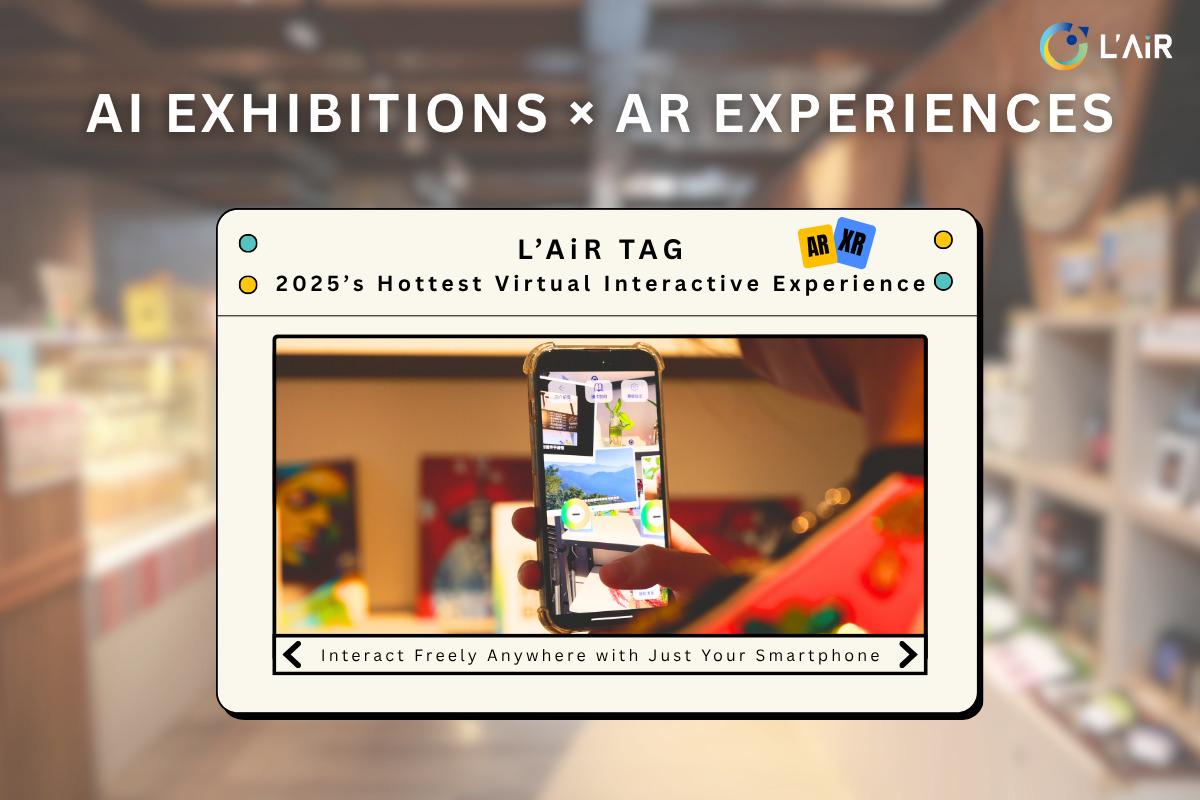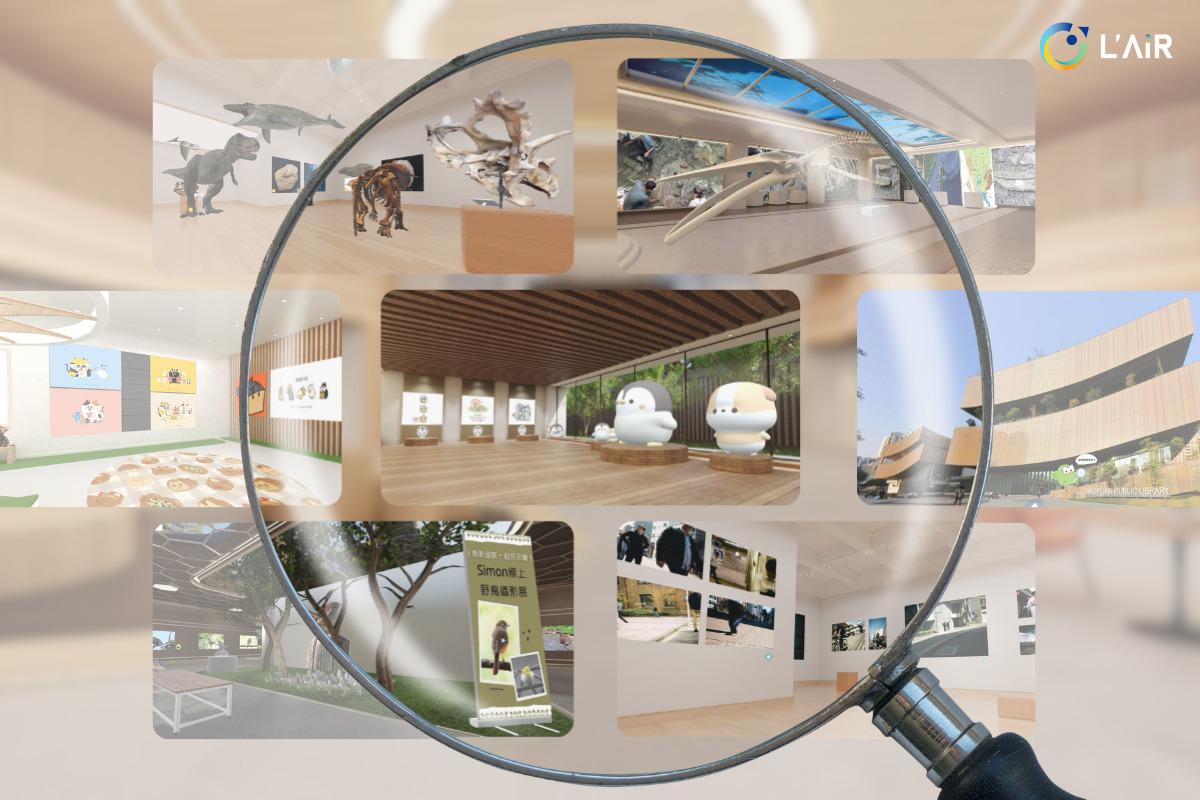From Curatorial Thinking to Creation: AI Exhibition × AR Interactive Design for Personalized Experiential Marketing
Catalog
- Transforming Curatorial Thinking: The Rise of Personalized AR & AI Exhibition Experiences
- One-way communication is no longer sufficient; audiences now crave immersive experiences.
- Three Key Shifts in Curatorial Thinking: From “Exhibition” to “Experience”
- AI Makes Every Visitor’s Experience Truly Unique
- AR Experiences Transform Exhibition Interaction, Bringing Hidden Stories to Life
- How AR Experiences Transform Exhibition Storytelling: 4 Exciting Applications
- AI Exhibitions Enter the Co-Creation Era: Crafting Personalized Experiences with Generative Interaction
- Three Key Applications of AI Exhibitions: Scenario Overvie
- AI and Co-Creation: Turning Exhibitions into an Interactive Stage for Visitors
- How AI Exhibitions and AR Experiences Are Transforming Personalized Experience Marketing
- Creating Audience-Centric Immersive Marketing Experiences
- How Experience Marketing Sparks Emotional Engagement Through Personalized Interaction Design
- From Unique Selling Points to Unique Experiences
- Creating Storytelling Motivations That Inspire Organic Social Sharing
- Building Brand Identity Through Personalized Interactions That Make Visitors Feel Understood
- AI Exhibitions and AR Interactive Design Are Redefining the Future of Curatorial Thinking
- Exhibitions Are No Longer Just “Viewing”—They Are Stepping Into the Story
When you enter an exhibition, what captures your attention first — the exhibits themselves, or the way you interact with them? Today’s audiences are no longer content with passive observation; they crave participation and seek personalized experiences that truly resonate.
Rooted in curatorial thinking, modern AI-powered exhibitions and AR experiences are no longer just about showcasing technology. They represent a new paradigm in interactive design and experiential marketing, redefining how audiences engage with content and brands.
By leveraging real-time AI responses to visitor behavior and AR storytelling that reveals hidden narratives, exhibitions are no longer one-size-fits-all. Each experience is tailored to the individual, creating deeper engagement and lasting impressions. This is not just technological advancement — it’s a transformation in marketing strategy, turning every visit into a memorable and meaningful journey.
Curious about how this new wave of exhibition innovation is achieved? Let’s explore how AI and AR are reshaping the future of interactive experiences.
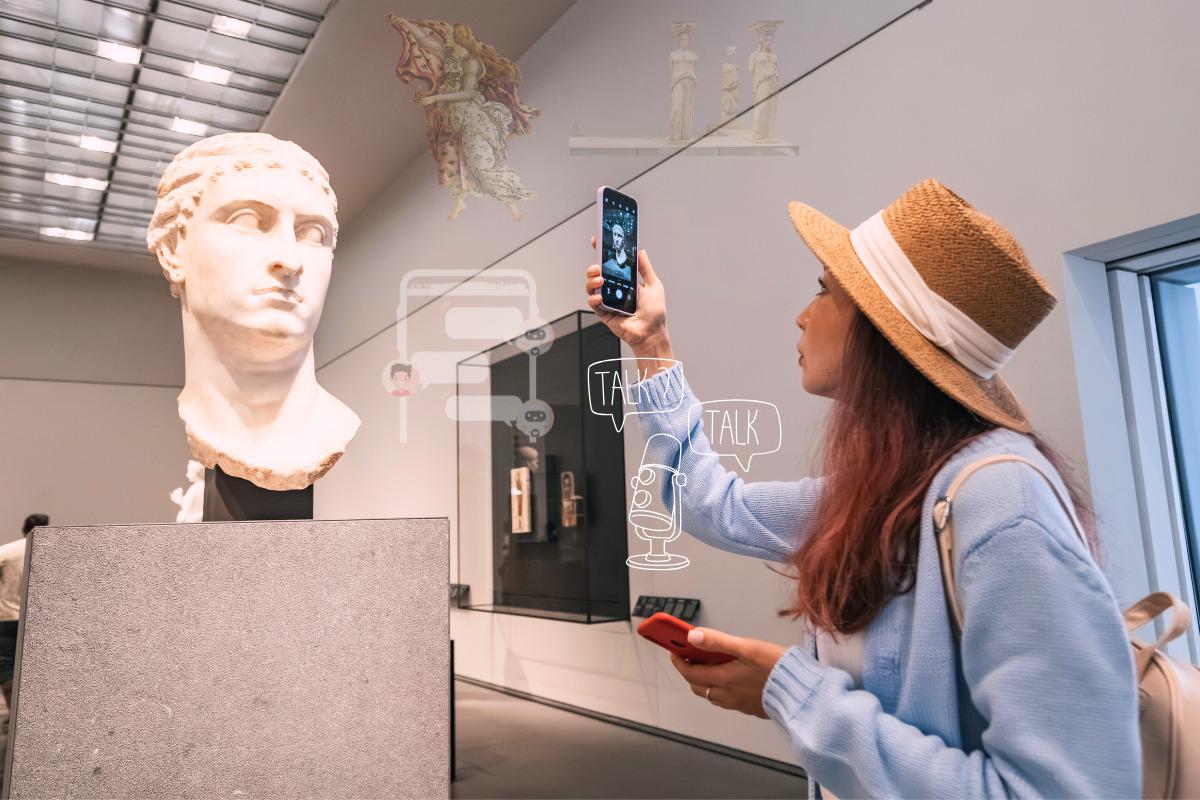
Image Source:King One Design
Transforming Curatorial Thinking: The Rise of Personalized AR & AI Exhibition Experiences
The mission of curators and designers has traditionally been to present valuable objects in the clearest and most aesthetically compelling manner. However, this approach belongs to an “object-centered” era, where the rarity, historical significance, or craftsmanship of the exhibits often determines the success of an entire exhibition.
Embedded within this curatorial mindset is a hierarchical knowledge structure: the curator serves as the sole narrator, while the audience remains a passive listener. Since exhibitions have long been regarded as a one-way transmission of knowledge, audience engagement tends to be minimal.
One-way communication is no longer sufficient; audiences now crave immersive experiences.
However, in today’s digital era of information overload, the traditional one-way curatorial approach is gradually losing its appeal. Audiences now acquire knowledge faster, more diversely, and with greater agency. When they enter an exhibition, they no longer seek merely a passive accumulation of information — instead, they desire:
▪️ An emotionally engaging journey through the exhibition
▪️ Content spaces that allow for meaningful interaction
▪️ Deep, personalized experiences that hold individual significance
This shift in audience expectations has given rise to the field of experiential interactive design, prompting curators to confront a pivotal question: How can we design exhibition experiences that truly merit the time and attention of our visitors?
Three Key Shifts in Curatorial Thinking: From “Exhibition” to “Experience”
The core of this curatorial transformation is shifting the focus from “what I want to show you” to “what you want to experience.” This is not merely a change in wording, but a fundamental reshaping of the entire curatorial process:
▪️ From one-way transmission to two-way interaction:
Exhibitions are no longer solely a one-way output from curators. Instead, they must be designed to foster an interactive environment where audiences can ask questions, actively explore, and even challenge the narrative. The role of the curator evolves from “educator” to “facilitator of dialogue.”
▪️ From standardized presentation to personalized experience:
Every visitor comes with unique backgrounds, preferences, and pathways through the exhibition. Curatorial design must incorporate flexible circulation and content options, allowing each individual to create their own journey. Exhibitions are no longer a single fixed version; they can offer hundreds or even thousands of personalized possibilities.
▪️ From functional display to emotional connection:
Design is no longer solely about clarity of information. It now seeks to generate emotional resonance. Storytelling, soundscapes, lighting, and interactivity are all essential elements that make an exhibition memorable. What truly leaves an impression is not the volume of information, but the emotional impact.
According to the 2025 international study “Artificial Intelligence Application for Museum to Experiential Transformation of Cultural Heritage and Learning”, AI accelerates the digital transformation of museums, enhancing visitor experiences through interactive and personalized content, while also supporting the preservation and dissemination of cultural heritage.
Moreover, the 2024 article “Dwells in Museum: The Restorative Potential of Augmented Reality” highlights that AR is increasingly recognized as a tool for creating restorative environments within museums. With the latest advances in Generative AI, AR technology can now be deeply integrated into museum experiences.
Taken together, it is clear that AI and AR have become the two most prominent technologies in contemporary museum curation. AI enables intelligent guidance and highly personalized content, while AR captures attention through immersive interactivity and the blending of physical and virtual experiences. Through these two core technologies, exhibitions are breaking traditional boundaries, allowing culture and storytelling to enter audiences’ worlds in more dynamic, interactive, and diverse ways, delivering unprecedented digital cultural experiences.
AI Makes Every Visitor’s Experience Truly Unique
As AI technology matures, exhibitions are no longer limited to pre-designed AR interactions to engage visitors. The core value of AI-powered exhibitions lies in their real-time responsiveness and generative capabilities. Visitors are no longer just clicking through functions; they can ask questions or converse, while AI generates personalized audio guides, narrative styles, and even custom visual content based on observed behaviors, language, or emotions:
▪️ Visitors who appreciate artistic creation may see the creative process behind the artworks.
▪️ Those interested in history may receive in-depth contextual information about the era.
This co-creative interaction transforms every visit into a truly unique experience. Visitors are no longer passive participants — they become co-creators of the content itself.
AR Experiences Transform Exhibition Interaction, Bringing Hidden Stories to Life
Augmented Reality (AR) acts like a pair of digital glasses — it doesn’t transport you into another virtual world, but rather overlays images, text, 3D models, or animations onto the real environment. In exhibitions, AR functions as a “super guide” for visitors, making details that are invisible to the naked eye both visible and interactive, while even fostering emotional connections.
How AR Experiences Transform Exhibition Storytelling: 4 Exciting Applications
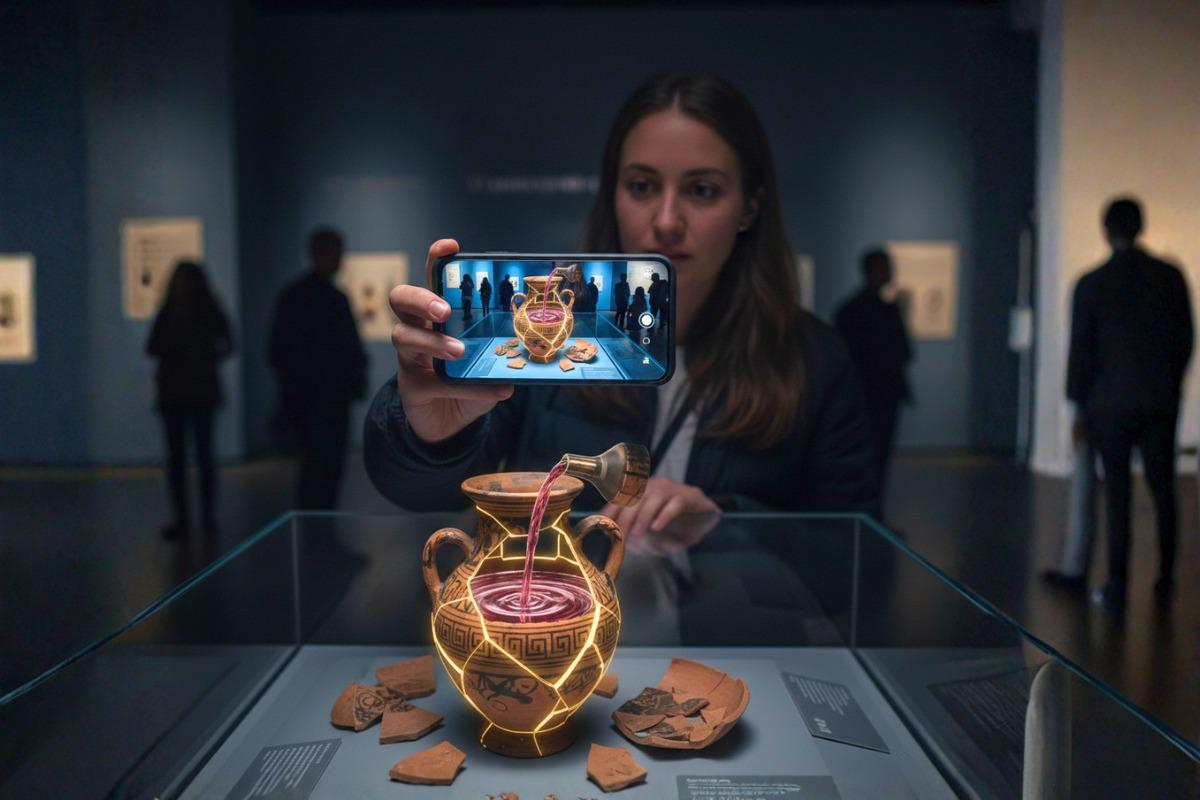
Image Source:King One Design
▪️ Historical Reconstruction: Bringing Cold Artifacts to Life
In museums, simply point your phone at a broken ancient pottery vessel, and the screen automatically reconstructs it into its intact form from two thousand years ago — even simulating the pouring of wine in its original context. AR transforms historical stories from imagination into first-hand visual experiences.
▪️ Structural Transparency: Seeing the Heart of Machinery
At an automotive exhibition, AR allows you to explore how pistons move and fuel injects without disassembling the engine. This intuitive interactive design greatly enhances visitors’ understanding of mechanical structures, creating a more impactful experience than traditional diagrams or text.
▪️ Art Co-Presence: Dialogues with the Masters
Step into a gallery and gaze at Starry Night. AR can bring “Van Gogh” to life, explaining his creative mindset and brushstroke details. This is not merely viewing art — it’s a time-transcending dialogue, enabling visitors to form a deep connection with the artist.
▪️ Commercial Applications: Bringing the Exhibition Home
At a furniture design exhibition, AR experiences allow visitors to “place” a sofa from the show directly into their living room. With just a photo, they can preview it at a 1:1 scale, instantly bridging the gap between imagination and reality.
The greatest advantage of AR lies in its ability to break the limitations of physical exhibits and add layers of information, transforming visitors from passive observers into active explorers. This process of discovery is inherently enjoyable and memorable, perfectly aligning with modern audiences’ expectations for immersive content.
AI Exhibitions Enter the Co-Creation Era: Crafting Personalized Experiences with Generative Interaction
If AR experiences add dazzling visual effects to a pre-defined narrative, generative AI represents a true revolution in personalized experiences. It transforms exhibitions from “viewing” into “co-creation”. AI no longer simply plays pre-produced content; instead, it generates unprecedented narratives and experiences in real time, responding to visitors’ language, movements, and emotions. What was once imagined as the future of personalized, one-to-one experiences has now become an accessible reality.
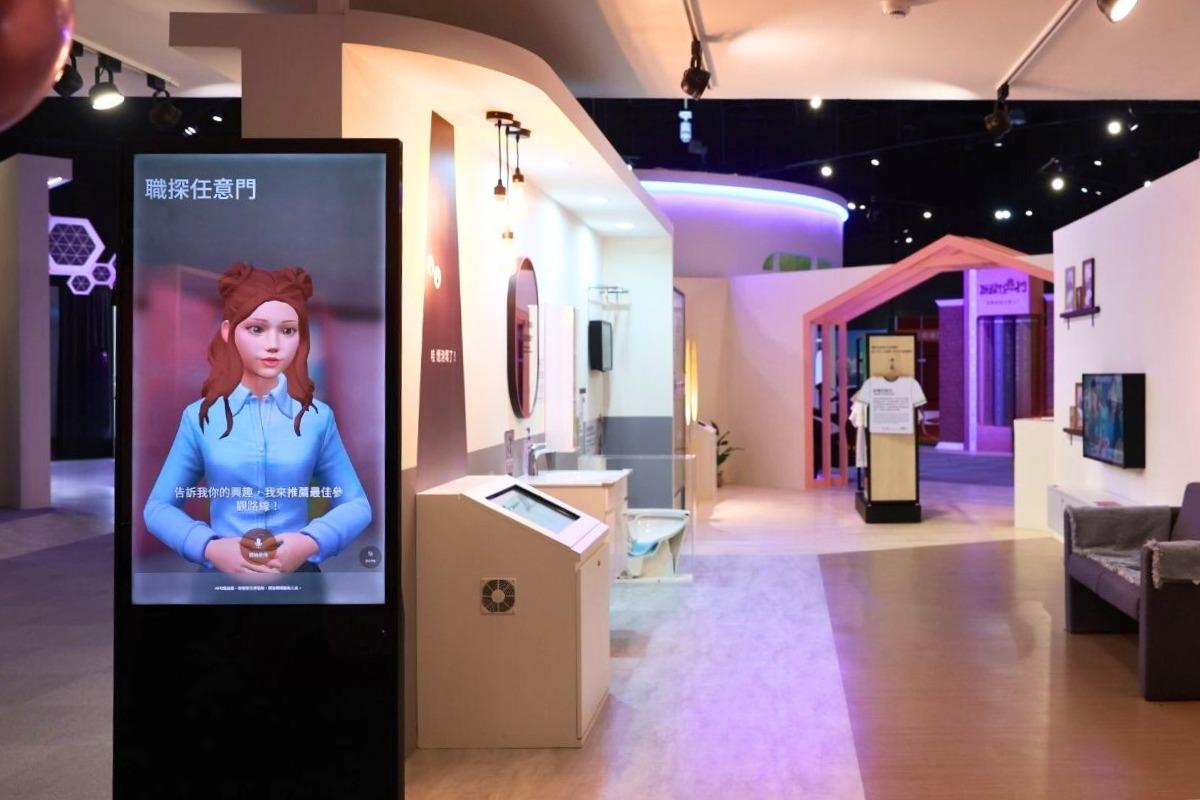
Image Source:King One Design
Three Key Applications of AI Exhibitions: Scenario Overvie
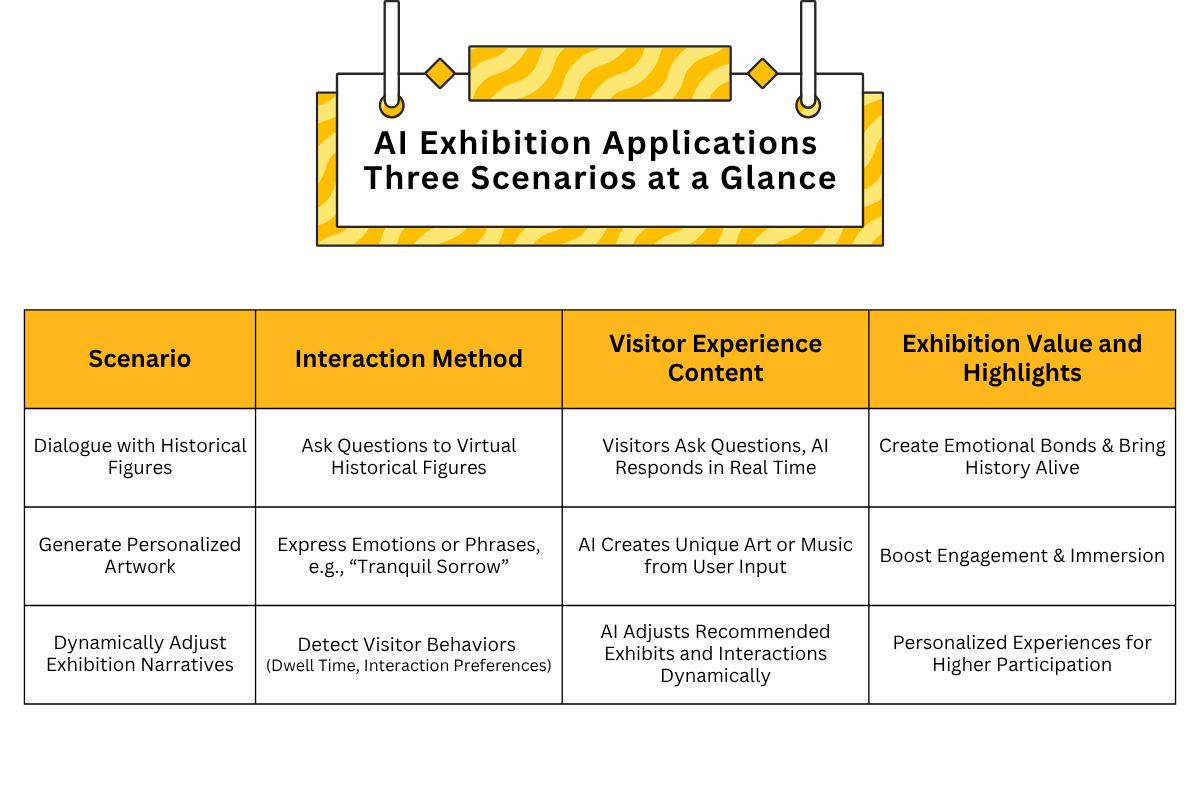
Image Source:King One Design
Based on real-time visitor data, AI can adjust content depth and recommendation paths, creating exhibition journeys tailored to each individual’s pace and interests, making every step closer to the experience they envision.
AI and Co-Creation: Turning Exhibitions into an Interactive Stage for Visitors
The core value of generative AI lies not only in interaction but in co-creation. Exhibitions are no longer a stage for one-way storytelling; they become an improvisational performance co-authored by visitors and AI. Every question asked, every choice made, and every moment of pause dynamically shapes the exhibition’s narrative. Such experiences are truly unique—no one else can replicate your journey, because this exhibition path is entirely your own.
How AI Exhibitions and AR Experiences Are Transforming Personalized Experience Marketing
When AI and AR join forces, a groundbreaking revolution in exhibition experiences quietly unfolds. This is not merely a cross-disciplinary application of technology—it marks a milestone in personalized experience marketing. In this immersive revolution, these two technologies work seamlessly, each playing a distinct role:
▪️ AI acts as a perceptive and attentive personal guide:
Silently observing your behaviors and choices, AI makes instant decisions: What do you want to see? Which content captures your interest? What is the optimal pace for your visit?
▪️ AR serves as the eyes that bring concepts to life:
AR translates AI’s intelligence into intuitive visual experiences on the front line. Through 3D simulations, virtual animations, and information overlays, content becomes tangible, allowing visitors not just to view the exhibition, but to step into it.
Creating Audience-Centric Immersive Marketing Experiences
Such exhibitions are no longer just about “viewing” displays—they become fully tailored interactive journeys. Every corner reveals a new surprise, and each piece of content aligns with your interests and curiosity. This is the charm of combining AI exhibitions and AR experiences with curatorial thinking and interactive design. It goes beyond a technological experience to become an emotionally engaging marketing strategy. When visitors form personal memories with an exhibition, the resulting brand impression is deeply embedded, naturally driving word-of-mouth and motivating return visits.
How Experience Marketing Sparks Emotional Engagement Through Personalized Interaction Design
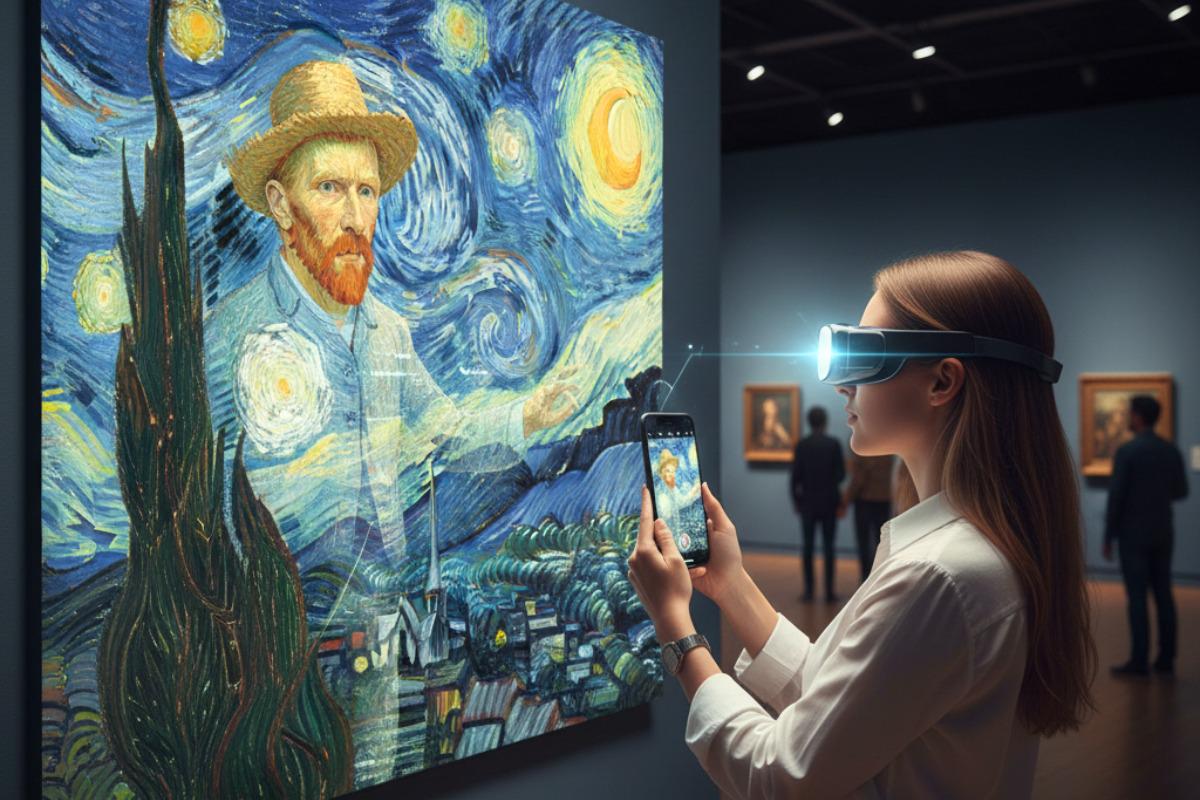
Image Source:King One Design
When an exhibition is not merely a display but a fully tailored experience, its value goes far beyond the content itself—it becomes a warm, engaging tool for experience marketing. Particularly in brand showcases, corporate culture centers, educational spaces, or museums, this combination of AI and AR-driven personalized interaction design serves as a key driver for building audience connections, increasing engagement, and generating positive word-of-mouth.
From Unique Selling Points to Unique Experiences
When an exhibition dynamically generates content, interactive Q&A, and personalized narratives based on visitors’ interests and behaviors, attendees are no longer mere spectators—they actively participate and co-create the experience. Such immersive experiences not only attract audiences and media attention but also create high engagement and memorable moments, making them a powerful tool in brand marketing.
Creating Storytelling Motivations That Inspire Organic Social Sharing
When a brand leverages AI and AR technologies to create a personalized journey for each visitor, it conveys more than technological prowess—it delivers an emotional experience where visitors feel valued and understood. This deep emotional connection not only enhances brand recall but also fosters long-term loyalty and positive brand perception—marketing outcomes that traditional advertising struggles to achieve.
Building Brand Identity Through Personalized Interactions That Make Visitors Feel Understood
When a brand leverages AI and AR technologies to craft a personalized journey for each visitor, it delivers more than just technological sophistication—it creates an emotional experience in which visitors feel valued and understood. This profound emotional connection not only enhances brand recall but also fosters long-term loyalty and positive brand perception, achieving marketing goals that traditional advertising often cannot.
AI Exhibitions and AR Interactive Design Are Redefining the Future of Curatorial Thinking
When AI and AR technologies are no longer just tools to support exhibitions but integral elements of curatorial practice, we are witnessing a profound transformation in exhibition logic. With the growing adoption of AR glasses and wearable devices, alongside the continuous evolution of generative AI, future exhibitions will no longer be confined by physical artifacts. Instead, they may evolve into fully interactive narrative spaces—spaces that breathe, converse, and intuitively respond to visitors’ needs.
Exhibitions Are No Longer Just “Viewing”—They Are Stepping Into the Story
One day in the near future, when you enter an exhibition, you will no longer be greeted by fixed panels and predetermined pathways. Instead, you will step into an immersive theater dynamically generated by AI and tailored to your personal preferences. The content you see will adapt to your behavior and background; exhibits will no longer be static objects but narrative nodes that speak to you and respond to your presence.
Yet, as we embrace these exciting technological applications, it is crucial to remember: technology is never the goal—it is a means. The soul of curatorial design does not lie in flashy interactive technologies, but in whether these tools can convey cultural warmth, express human emotion, and evoke audience resonance. A truly successful exhibition is never about showing off technology—it is about making visitors feel: “This story is my story!”
If you are considering how to make your brand, space, or exhibition break free from convention and engage in meaningful dialogue with your audience, connect with L’AiR today, and embark on a curatorial journey that truly moves the heart.
- 1
6 Different Types of Trade Show Booths You Need to Know
Brand Strategy
- 2
What is CIS? Corporate Identity Design that goes hand in hand with exhibition design
Tech Life & Trends
- 3
How to do commercial space planning? 4 recommended works of commercial space design take you to understand the corporate philosophy
Brand Strategy
- 4
What you need for Situational Design - 2.5 D
Exclusive Perspective
- 5
SAVE THIS PAGE! Useful Vocabulary and Sentences for Exhibition Goers and Exhibitors!
Exclusive Perspective
- 6
3D Logo - The Little Secret in Exhibition Design
Exclusive Perspective












